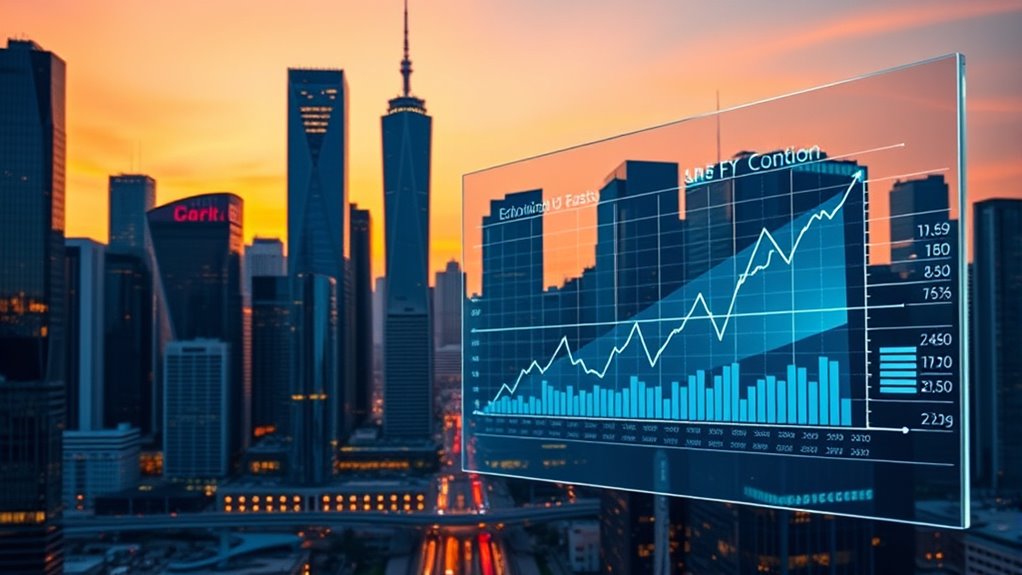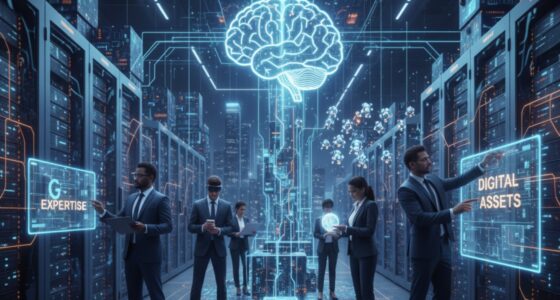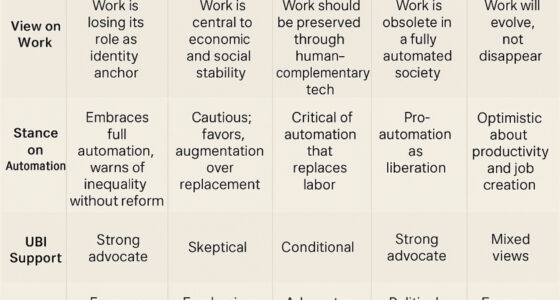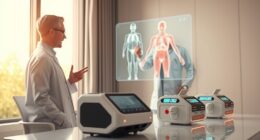In an era of rapid automation and AI, traditional GDP measures fall short of capturing true economic progress. They overlook productivity gains, job shifts, and how benefits often favor capital owners, not everyone. As automation reshapes work and wealth, you’ll see that new metrics now emerge to better reflect well-being, inequality, and sustainability. If you want a clearer picture of what these changes mean, keep exploring how policies and measurements are evolving.
Key Takeaways
- Automation improves productivity but often increases wealth inequality, which GDP does not account for.
- Traditional GDP overlooks job displacement, gig work, unpaid labor, and digital contributions caused by automation.
- New metrics are needed to measure well-being, social equity, and environmental sustainability beyond GDP figures.
- AI-driven economic growth may not reflect actual improvements in living standards or social welfare.
- Relying solely on GDP risks misrepresenting progress in an increasingly automated and digital economy.
Rethinking Traditional Economic Indicators in an Automated World

As automation transforms economies, relying solely on traditional indicators like GDP no longer provides a complete picture of economic well-being. While GDP measures output, it doesn’t account for automation’s effects, like productivity gains or job shifts. Automation boosts productivity and can drive economic growth, but benefits often go to capital owners, not workers, skewing traditional metrics. Job displacement and creation complicate employment figures, making GDP less reflective of actual economic health. Automation also widens inequality, with wealth concentrating among those controlling capital. Technological advances may increase GDP, yet they don’t always improve social welfare or reflect changes in living standards. Recognizing the importance of Strategy and Mastery can help develop a more comprehensive understanding of societal progress. As a result, you need to look beyond GDP to understand the real impact of automation on society’s economic landscape. Additionally, traditional measures often overlook worker well-being and the quality of employment, which are crucial indicators of economic health in an automated world. Moreover, understanding the distribution of benefits from automation is essential to assessing overall societal progress. Incorporating innovative metrics that account for social and environmental factors can provide a more balanced view of economic development in the age of automation.
The Impact of AI and Robotics on Measuring Economic Success

Automation and AI are rapidly reshaping how we measure economic success, revealing limitations in traditional metrics like GDP. You might see higher GDP figures, but these don’t tell the whole story. AI could boost global GDP by $7 trillion over ten years, with every dollar invested generating $4.60 in the economy. Most gains come from labor productivity improvements, yet the true impact extends beyond numbers. Consider:
AI and automation boost GDP but also reshape well-being and work-life balance beyond just numbers.
- Productivity gains from robotics could reduce working hours, not just increase output
- AI might displace nearly 40% of jobs worldwide
- Robots could improve work-life balance by handling mundane tasks
- AI-driven innovation may lead to significant consumption increases
- Traditional metrics may miss improvements in human well-being and quality of life
- AI’s economic contribution is projected to reach $19.9 trillion by 2030, highlighting its substantial impact on global growth
- Understanding the limitations of GDP helps us develop more comprehensive measures of prosperity and well-being. Additionally, the evolving nature of productivity metrics underscores the importance of integrating new economic indicators that better reflect societal progress.
- Recognizing these challenges prompts us to reevaluate our reliance on traditional economic metrics and explore alternative ways to assess societal success. For example, incorporating well-being metrics could provide a more holistic view of economic health and societal progress.
Workforce Shifts and Their Reflection in GDP Figures
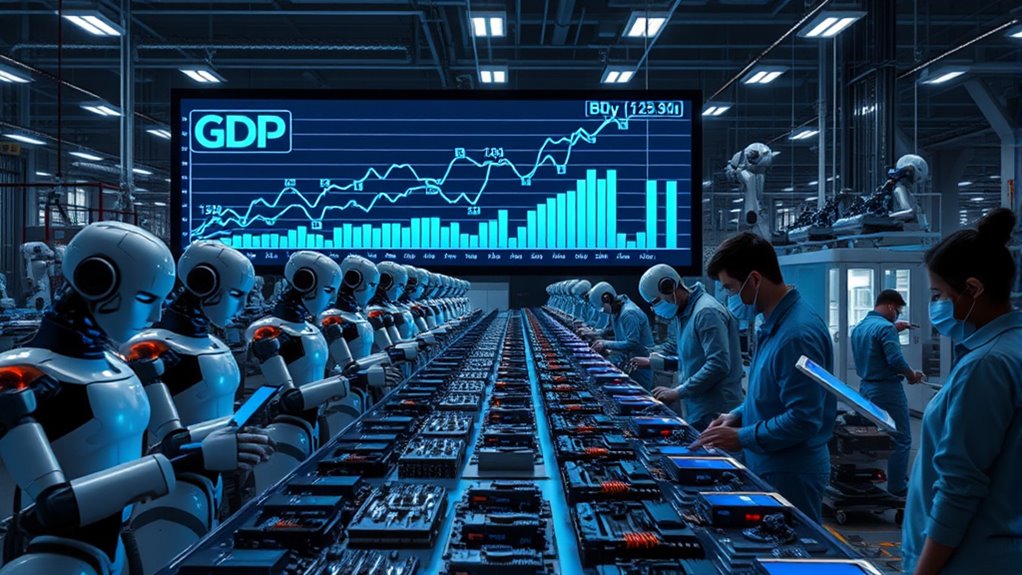
Workforce shifts driven by automation are transforming the composition and size of the labor market, yet these changes often go unnoticed in traditional GDP figures. As about 12.6% of U.S. jobs—mainly routine, blue-collar, and service roles—face automation risks, employment patterns shift rapidly. Globally, 14% of workers have already been displaced by AI, prompting millions to retrain for new roles, often in tech-related fields projected to grow 25% by 2030. These changes create new job categories, especially in managing and maintaining automated systems, but also lead to labor market fragmentation and economic uncertainty. Meanwhile, traditional GDP measures typically overlook unpaid work, gig jobs, and the value created through new digital and AI-driven roles, making it hard to fully capture the true scope of workforce evolution. Additionally, the integration of AI in Education and other automation technologies is reshaping skill requirements and workforce development strategies. As automation accelerates, employment patterns are evolving faster than traditional metrics can accurately reflect, raising questions about how we measure economic progress and well-being. Recognizing the hidden contributions of digital labor and automation is essential for a more comprehensive understanding of economic health, especially considering the displacement of jobs that often goes unmeasured in standard economic indicators. Furthermore, accounting for unpaid work and new digital contributions is crucial for developing a balanced view of economic growth in the automation era.
Alternative Metrics Emerging in the Age of Automation
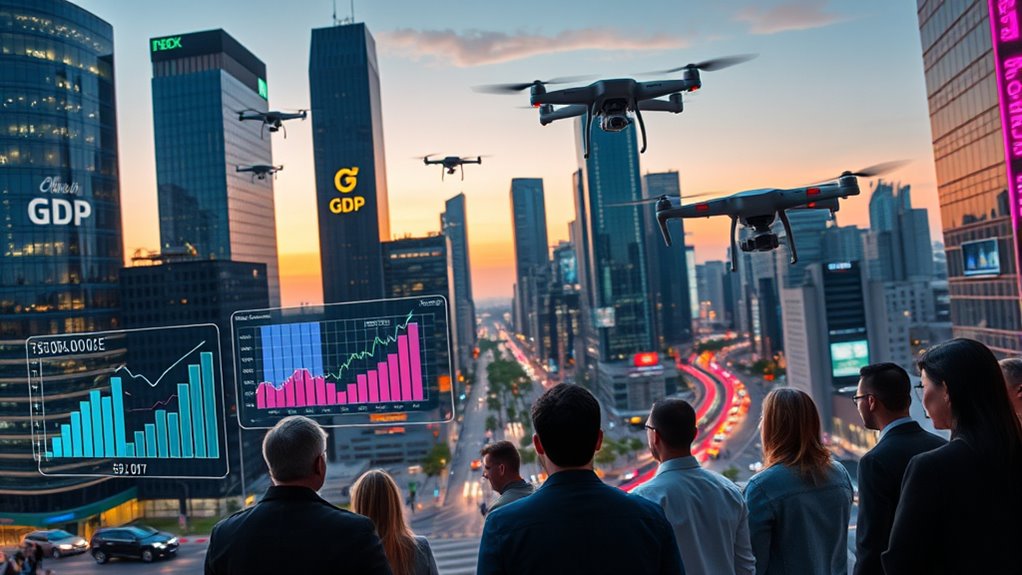
In the age of automation, traditional GDP figures often fall short of capturing the full scope of economic activity and societal well-being. To better reflect this new landscape, emerging metrics focus on various aspects beyond output. You might consider:
- New measures that track productivity gains from AI and automation, not just goods produced.
- Indicators evaluating how automation benefits different social groups and reduces inequality.
- Adjusted labor market metrics that reflect shifts in tasks and wage patterns.
- Well-being measures, like income security, health, and leisure, that go beyond economic output.
- Environmental and sustainability indicators to evaluate long-term ecological impacts.
- Data privacy and security considerations are crucial when utilizing new measurement approaches to ensure ethical standards are maintained.
- Digital dead drops and clandestine communication methods as innovative ways to monitor and understand societal shifts in the context of automation.
- Additionally, developing risk assessment frameworks can help quantify uncertainties associated with new metrics and ensure their robustness.
- Incorporating social equity metrics can highlight how automation influences different communities and promotes inclusive growth.
These alternative metrics aim to give a clearer picture of true progress, helping policymakers and society understand automation’s broader effects beyond traditional GDP numbers.
Challenges and Opportunities for Policy in a Changing Economic Landscape
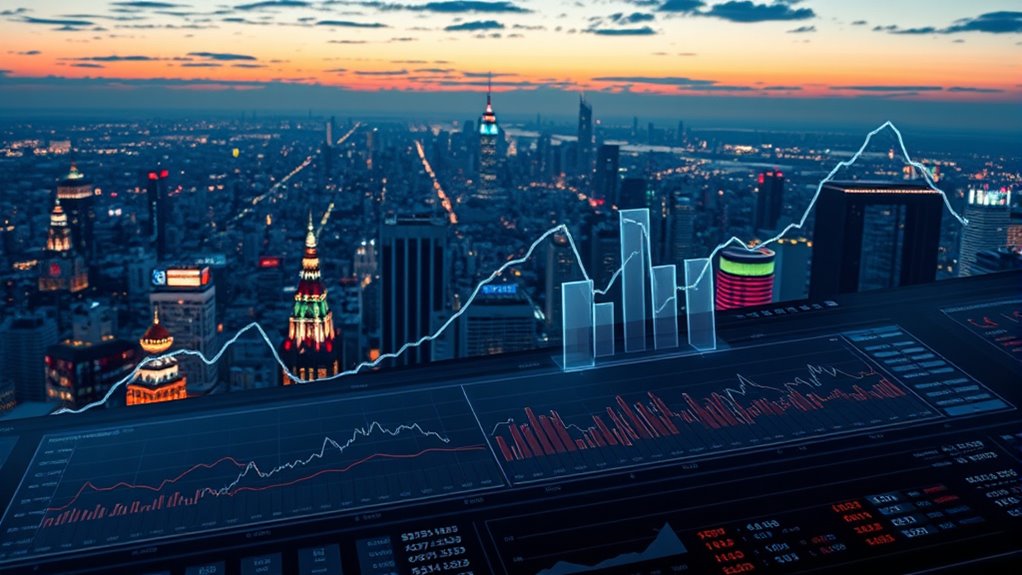
As economies undergo rapid technological change, policymakers face the complex task of managing labor market disruptions while fostering continued growth. You need to address job displacement caused by automation, such as roles in data entry and administrative support, which are expected to decline considerably. Simultaneously, you should promote retraining and reskilling programs to help workers transition into emerging sectors. Consider this overview:
| Challenge | Opportunity | Policy Focus |
|---|---|---|
| Job losses from automation | New tech-driven roles | Invest in education and lifelong learning |
| GDP forecasting difficulties | Productivity gains from AI | Enhance economic models to include automation effects |
| Increasing inequality | Broad benefits from innovation | Strengthen social safety nets and inclusive growth strategies |
Incorporating home decor principles like adaptable spaces and aesthetic solutions can also facilitate flexible work environments, supporting the evolving needs of the workforce. Additionally, understanding the impact of cookies on user experience can help improve digital engagement strategies for policymakers and stakeholders. Recognizing the importance of security in digital systems is essential as cyber threats continue to evolve alongside technological advancements. Balancing these factors is vital for shaping resilient policies in an evolving economic landscape. Emphasizing economic theory can help policymakers develop more accurate forecasts and effective interventions.
Frequently Asked Questions
How Can Governments Accurately Measure Productivity Gains From Automation?
You can accurately measure productivity gains from automation by tracking input costs and output quality, using methods like activity-based costing. Engage employees and foster organizational flexibility to adapt to new technologies. Regularly monitor progress, collect precise data, and collaborate with external partners. Emphasize incremental reforms and cultural change, ensuring automation’s benefits are reflected in improved efficiency and service quality, even if traditional metrics struggle to capture these advancements fully.
What Role Do Intangible Assets Play in Assessing Economic Growth Today?
You might think you understand economic growth, but intangible assets challenge that view. These assets—like R&D, brands, and software—drive innovation and productivity, yet traditional metrics often overlook them. As their value skyrockets, your perception of economic health shifts. By recognizing their role, you’ll see a more accurate, nuanced picture—one that captures the true pulse of today’s economy, where intangible contributions are as crucial as tangible ones.
Are Current GDP Metrics Sensitive Enough to Capture the Value of AI Innovations?
You might wonder if current GDP metrics are sensitive enough to capture AI innovations’ true value. The truth is, they often fall short because traditional measures struggle to account for digital assets and intangible benefits like efficiency gains. AI’s impact includes automation and productivity boosts that aren’t fully reflected in GDP figures, meaning we could be underestimating its economic importance. To truly understand AI’s influence, we need more nuanced, adaptable metrics.
How Might Automation Influence Income Inequality and Its Reflection in Economic Data?
Ever wonder how automation shifts income inequality? It can widen the gap as high-skilled workers boost productivity and wages, while low-skilled workers face displacement and wage declines. Economic data often shows increased wealth concentration among capital owners, not workers. Does this mean our traditional metrics fully capture these disparities? Probably not, since GDP growth might hide growing inequality, emphasizing the need for better measures to reflect economic realities in the automation era.
What New Policies Could Better Support Economic Resilience Amid Automation-Driven Changes?
You should focus on policies that promote workforce adaptability, like retraining programs and education initiatives, to support economic resilience. Encouraging innovation through R&D incentives and digital infrastructure investments helps businesses stay competitive amid automation. Strengthening social safety nets guarantees stability for displaced workers. Additionally, fostering flexible regulatory frameworks allows quick adaptation to technological changes, ensuring the economy remains resilient and inclusive as automation transforms industries.
Conclusion
You might think GDP is still the best way to measure economic health, but automation challenges that idea. As AI and robots reshape work, traditional metrics can overlook true progress and well-being. While some argue GDP remains essential, embracing new indicators gives you a clearer picture of prosperity in this automated age. By doing so, you can better understand and navigate a future where measurement matters just as much as innovation itself.
